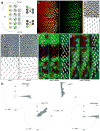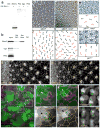Nemo kinase phosphorylates β-catenin to promote ommatidial rotation and connects core PCP factors to E-cadherin-β-catenin
- PMID: 21552260
- PMCID: PMC3109122
- DOI: 10.1038/nsmb.2049
Nemo kinase phosphorylates β-catenin to promote ommatidial rotation and connects core PCP factors to E-cadherin-β-catenin
Abstract
Frizzled planar cell polarity (PCP) signaling regulates cell motility in several tissues, including ommatidial rotation in Drosophila melanogaster. The Nemo kinase (Nlk in vertebrates) has also been linked to cell-motility regulation and ommatidial rotation but its mechanistic role(s) during rotation remain obscure. We show that nemo functions throughout the entire rotation movement, increasing the rotation rate. Genetic and molecular studies indicate that Nemo binds both the core PCP factor complex of Strabismus-Prickle, as well as the E-cadherin-β-catenin (E-cadherin-Armadillo in Drosophila) complex. These two complexes colocalize and, like Nemo, also promote rotation. Strabismus (also called Vang) binds and stabilizes Nemo asymmetrically within the ommatidial precluster; Nemo and β-catenin then act synergistically to promote rotation, which is mediated in vivo by Nemo's phosphorylation of β-catenin. Our data suggest that Nemo serves as a conserved molecular link between core PCP factors and E-cadherin-β-catenin complexes, promoting cell motility.
Figures






Similar articles
-
Nemo regulates cell dynamics and represses the expression of miple, a midkine/pleiotrophin cytokine, during ommatidial rotation.Dev Biol. 2013 May 1;377(1):113-25. doi: 10.1016/j.ydbio.2013.02.006. Epub 2013 Feb 18. Dev Biol. 2013. PMID: 23428616 Free PMC article.
-
Prickle is phosphorylated by Nemo and targeted for degradation to maintain Prickle/Spiny-legs isoform balance during planar cell polarity establishment.PLoS Genet. 2018 May 14;14(5):e1007391. doi: 10.1371/journal.pgen.1007391. eCollection 2018 May. PLoS Genet. 2018. PMID: 29758044 Free PMC article.
-
Diego and Prickle regulate Frizzled planar cell polarity signalling by competing for Dishevelled binding.Nat Cell Biol. 2005 Jul;7(7):691-7. doi: 10.1038/ncb1271. Epub 2005 Jun 5. Nat Cell Biol. 2005. PMID: 15937478
-
How do the Fat-Dachsous and core planar polarity pathways act together and independently to coordinate polarized cell behaviours?Open Biol. 2021 Feb;11(2):200356. doi: 10.1098/rsob.200356. Epub 2021 Feb 10. Open Biol. 2021. PMID: 33561385 Free PMC article. Review.
-
Wnt-frizzled planar cell polarity signaling in the regulation of cell motility.Curr Top Dev Biol. 2022;150:255-297. doi: 10.1016/bs.ctdb.2022.03.006. Epub 2022 May 25. Curr Top Dev Biol. 2022. PMID: 35817505 Free PMC article. Review.
Cited by
-
Notch-dependent Abl signaling regulates cell motility during ommatidial rotation in Drosophila.Cell Rep. 2022 Dec 6;41(10):111788. doi: 10.1016/j.celrep.2022.111788. Cell Rep. 2022. PMID: 36476875 Free PMC article.
-
Cell adhesion in Drosophila: versatility of cadherin and integrin complexes during development.Curr Opin Cell Biol. 2012 Oct;24(5):702-12. doi: 10.1016/j.ceb.2012.07.006. Epub 2012 Aug 28. Curr Opin Cell Biol. 2012. PMID: 22938782 Free PMC article. Review.
-
Integrins are required for synchronous ommatidial rotation in the Drosophila eye linking planar cell polarity signalling to the extracellular matrix.Open Biol. 2019 Aug 30;9(8):190148. doi: 10.1098/rsob.190148. Epub 2019 Aug 14. Open Biol. 2019. PMID: 31409231 Free PMC article.
-
Nemo-like kinase regulates postnatal skeletal homeostasis.J Cell Physiol. 2014 Nov;229(11):1736-43. doi: 10.1002/jcp.24625. J Cell Physiol. 2014. PMID: 24664870 Free PMC article.
-
Notch signaling coordinates ommatidial rotation in the Drosophila eye via transcriptional regulation of the EGF-Receptor ligand Argos.Sci Rep. 2019 Dec 9;9(1):18628. doi: 10.1038/s41598-019-55203-w. Sci Rep. 2019. PMID: 31819141 Free PMC article.
References
-
- Wolff T, Ready DF. Pattern formation in the Drosophila retina. In: Martinez-Arias MBA, editor. The development of Drosophila melanogaster. Cold Spring Harbor Press; Cold Spring Harbor: 1993. pp. 1277–1326.
-
- Seifert JR, Mlodzik M. Frizzled/PCP signalling: a conserved mechanism regulating cell polarity and directed motility. Nat Rev Genet. 2007;8:126–38. - PubMed
-
- Wang Y, Nathans J. Tissue/planar cell polarity in vertebrates: new insights and new questions. Development. 2007;134:647–58. - PubMed
-
- Mirkovic I, Mlodzik M. Cooperative activities of drosophila DE-cadherin and DN-cadherin regulate the cell motility process of ommatidial rotation. Development. 2006;133:3283–93. - PubMed
Publication types
MeSH terms
Substances
Grants and funding
LinkOut - more resources
Full Text Sources
Molecular Biology Databases
Miscellaneous

